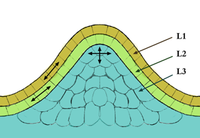
Photo from wikipedia
In plants, carbon source-sink relationships are assumed to affect their reproductive effort. In fruit trees, carbon source-sink relationships are likely to be involved in their fruiting behavior. In apple, a… Click to show full abstract
In plants, carbon source-sink relationships are assumed to affect their reproductive effort. In fruit trees, carbon source-sink relationships are likely to be involved in their fruiting behavior. In apple, a large variability in fruiting behaviors exists, from regular to biennial, which has been related to the within-tree synchronization vs desynchronization of floral induction in buds. In this study, we analyzed if carbon assimilation, availability and fluxes as well as shoot growth differ in apple genotypes with contrasted behaviors. Another aim was to determine the scale of plant organization at which growth and carbon balance are regulated. The study was carried out on 16 genotypes belonging to three classes: (i) biennial, (ii) regular with a high production of floral buds every year and (iii) regular, displaying desynchronized bud fates in each year. Three shoot categories, vegetative and reproductive shoots with or without fruits, were included. This study shows that shoot growth and carbon balance are differentially regulated by tree and shoot fruiting contexts. Shoot growth was determined by the shoot fruiting context, or by the type of shoot itself, since vegetative shoots were always longer than reproductive shoots whatever the tree crop load. Leaf photosynthesis depended on the tree crop load only, irrespective of the shoot category or the genotypic class. Starch content was also strongly affected by the tree crop load with some adjustments of the carbon balance among shoots since starch content was lower, at least at some dates, in shoots with fruits compared with the shoots without fruits within the same trees. Finally, the genotypic differences in terms of shoot carbon balance partly matched with genotypic bearing patterns. Nevertheless, carbon content in buds and the role of gibberellins produced by seeds as well as the distances at which they could affect floral induction should be further analyzed.
Journal Title: Tree Physiology
Year Published: 2018
Link to full text (if available)
Share on Social Media: Sign Up to like & get
recommendations!